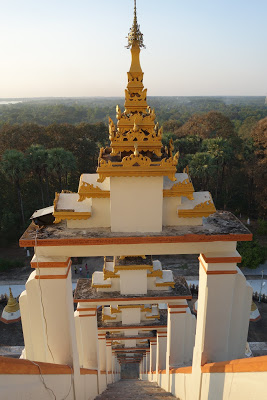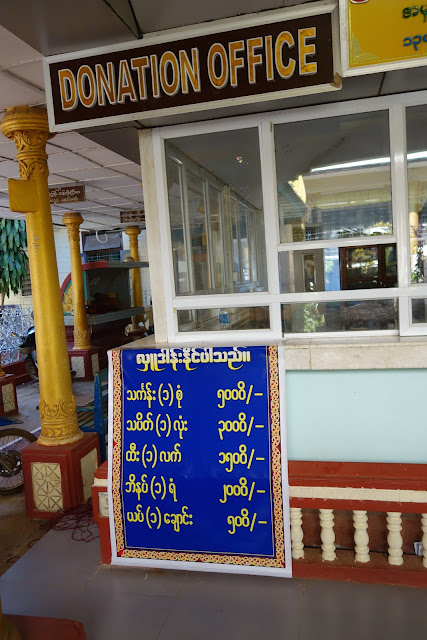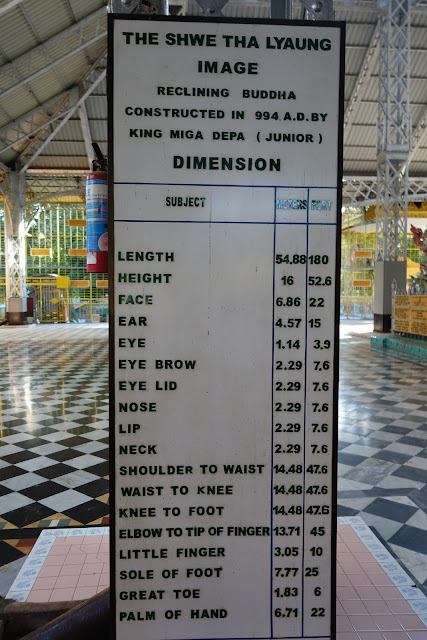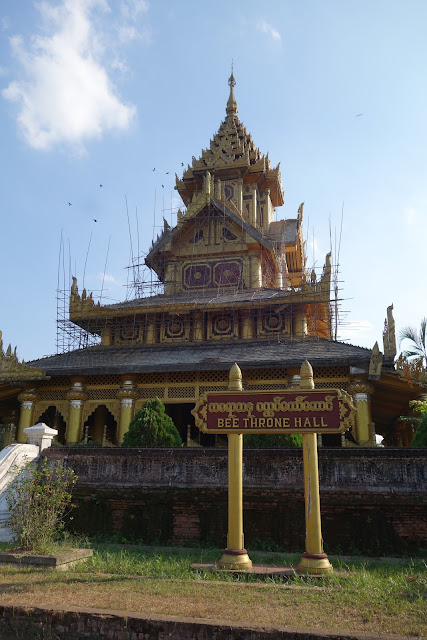
My Trip to Burma: Bago, an interesting city to end our amazing trip.
Well, I had a mediocre night’s sleep. Ambien just doesn’t seem to work for me anymore. I was hoping for a good night’s sleep, because we have a grueling day ahead. Hours of sightseeing, then a few hours at the airport (our flight leaves at 10 minutes to midnight), then five hours on a plane to Beijing, seven hours on a layover in Beijing (ugh!), and then almost 14 hours to JFK airport. Hey, it is what it is. We met back up with Myo, our guide from our very first day. Our bags were loaded into the car, and off we went to Bago. Located a 90 minute drive northeast of Yangon, and formerly known as Pegu, the town of Bago was the capital of several Mon and Burmese kingdoms, and flourished as a bastion of Theravada Buddhism in the 15thcentury, and then as a regional trade center in the 16th century. Each time a new kingdom arose, new gilded pagodas and reclining Buddhas were added. This quiet, scruffy little provincial market town now boasts a spectacular crop of monuments spanning more than 1400 years of history. Bago has been chosen as the location for Yangon’s new Hanthawaddy International Airport, so the town will become even more accessible, if the project ever is completed. (It started in 1994, so don’t hold your breath.)
The drive to Bago took a while, and wasn’t very scenic, I’m afraid. But as we headed north toward Inya Lake, I knew we were getting close to Aung San Suu Kyi’s home, so I asked if we could take a detour and see it.
Outside are prominent signs indicating that this is the headquarters of the National League for Democracy, and there’s a picture of her father, General Aung San, at the top.
The place was unguarded, amazingly. I aimed my camera at a little crevice between the two pieces of the gate and took a picture of the home and the yard.
Then we drove by the American Embassy. I took a photo and was immediately yelled at by some security guards as we drove by. I was worried that they were going to actually follow us, but they didn’t. They were definitely not pleased, though.
Our first stop was Kya Kha Wain Kyaung, Bago’s biggest monastery. It formerly housed 1200 monks, although many were forced to return to their home communities after the crackdown that followed 2007’s Saffron Revolution. Today there are about 500 monks remaining. The monastery is best known for its 11:00 a.m. lunchtimes, where busloads of Thai tourists descend to watch monks march in procession to receive alms from the tourists.
Traffic was terrible and we arrived a little after 11:00, but there are a lot of monks there, and the procession was still in progress. The entire spectacle was reminiscent of feeding time at the zoo, and many of the monks, it seemed to me, could barely hide their disgust. However, these monasteries depend on donations, and many people do make donations while visiting (including us), so the monks put up with it. Actually, several of the monks were pretty cheerful while we were taking photos. We watched as the monks ate their one meal for the day.
On some tables nearby were all sorts of items that the monks use in their daily lives. Robes, sandals, alms bowls, etc. These are available for purchase, as donations. You give a donation, and then the monks can take one of the items you purchased, to use for themselves.
We went to the donation office, and Mark made the donation.
I don’t know… I just find the monks fascinating. Every boy from a Buddhist family spends at least a little time ordained as a monk, usually entering a monastery for a few days in a celebratory ceremony at around the age of eight. The family gives a big party and guests donate supplies to the monastery in honor of the occasion. Later on, a young man will spend a month or more as a monk, shaving his head and living in a monastery. Being a monk has its advantages. Everyone opens a path to let them pass through a crowd, or lets them go ahead when there’s a line.
Being a monk does have its obligations, though. Every morning, they must go out and accept alms. All over the country, at the break of dawn, monks of all ages walk barefoot in single file through the streets, carrying their alms bowl. Residents who have prepared rice and other food stand waiting by the side of the road. As the monks pass, the locals put a small amount of their offering in each monk’s bowl, accepting the monk’s blessing. Once the alms round is completed, the monks return to the monastery. The morning offering usually becomes the monk’s breakfast. Just before noon, they take their big lunch, which is usually paid for by donations. They then take no food or drink until the next morning. Looks like this monk is taking his friend’s pulse, doesn’t it?
In September 2007, monks in Burma did something very out of character. They openly engaged in political action. This was known as the “Saffron Revolution” (so named because Buddhist monks in many countries wear saffron yellow robes, although ironically not in Burma). The monks marched in peaceful protest against the repressive government. The demonstrations started in the town of Pakkoku, which is on the Ayeyarwaddy River just north of Bagan. They quickly spread to Yangon, Mandalay, and elsewhere. The army opened fire on the monks, killing many of them, as well as many other residents. Many demonstrators were imprisoned. As the country began to open to democracy in 2012, a lot of the prisoners were released. Monks have always been treated with great respect in Burma. The Saffron Revolution increased their standing in Burmese society even further.
The Shwemawdaw Pagodawas our next stop, and is probably the highlight of Bago. The vast golden dome of the Shwemawdaw Pagoda dominates Bago’s skyline. In the car, you could easily see the stupa up ahead in the road. Unfortunately, the upper 80% was covered in bamboo scaffolding, as the stupa was undergoing renovations. Our guide said that every four years, for about four months, the stupa is renovated.
No monument in the region conveys the power and wealth of the lost kingdom of the Mons as dramatically as the Shwemawdaw. Buddhist legend has it that a pair of merchant brothers built the monument to enshrine two of the Buddha’s hairs, gifted by Gautama himself in 582 BC, with successive generations adding relics and extending the spire to its current height of 114 meters, which is even taller than the Shwedagon in Yangon, and then covering it with 1.5 tons of gold leaf. It is now Myanmar’s tallest stupa. As you can clearly see now, the upper portion is obscured by scaffolding.
The terrace was really nice. It reminded me a little bit of the Shwedagon Pagoda, but certainly not nearly as ornate.
There was a huge gong on the terrace, which we got to ring.
Numerous earthquakes have taken their toll on the stupa. A big chunk of brickwork that collapsed in 1917 is dramatically embedded in the western side. I thought this was the coolest part of the pagoda site. Devotees gather around the hunk of bricks and shove incense in cracks in the mortar.
The most recent earthquake, in 1930, caused the pagoda to lay in ruins for 20 years until unpaid volunteers built the structure you see now, in the early 1950’s.
Also at the pagoda was a bamboo Buddha!
The weirdest place we visited was the Snake Monastery,which I guess you could call one of Bago’s less orthodox religious sites. This monastery (also known locally as Mwei Paya) is home to a venerable Burmese python. Estimated to be an incredible 120 years old, the 5 meter long female snake is said to be the reincarnation of an abbot from a monastery in Hsipaw. The snake now divides her time between sleeping and scarfing down chickens. Our guide said they feed her 7 chickens every 45 days.. Five monks are required to carry the snake between enclosures. Visitors are occasionally allowed to touch the snake, except during the Burmese month of Waso (June-July), when it is said to be fasting.
At first glance, the buildings on the monastery site look fancily constructed with gold and red columns and trim, but when you look closely, you can see that it’s not much more than ornate aluminum siding. Behind a little teahouse on the site, there’s a work area where young male metalworkers skillfully hammer out the nice designs. I was impressed.
We took a break before heading to our next site. Nothing like a super fresh coconut juice to recharge the batteries.
Two km west of Bago is the star attraction on the west side of town, the 10th-century Shwethalyaung Reclining Buddha. It was built by King Migadepa in 994 AD to celebrate his conversion to Buddhism. The 55 meter (almost 180 feet) long statue shows Buddha resting his head on an ornate pillow on the eve of his enlightenment. After Alaungpaya sacked Bago in 1756, the statue was abandoned and was left forgotten and overgrown with weeds in the jungle, until it was rediscovered by British railway contractors in 1880. It’s pretty amazing. The thing is huge, and the pillow it lays on is spectacular.
The statue’s serene expression and countenance is meant to covey to worshippers the joy the Buddha experienced on his deathbed at the moment of entering parinirvana, as well as the meaning of his final words to his assembled disciples: “All living things are subject to decay; strive with diligence for your liberation.”
There were plaques all around the Buddha honoring those who had made large donations at this site. Their definition of a large donation is 100,000 kyat, which is about 85 dollars! Yes, you can get your name immortalized at this site for less than $100. Much more affordable than the cost of “adopting” a bench in New York’s Central Park ($10,000).
There was a sign nearby that gave the dimensions of various parts of the statue, in both meters and feet. On the back side of the reclining Buddha were a series of elaborately painted scenes depicting various key events in the Buddha’s life.
As if this Buddha wasn’t large enough, we headed down the road to an even more massive reclining Buddha, the Nawdawgyi Myathalyaung Buddha. This monumental Buddha is oriented east to west, compared to the previous one, which was north to south. This one was built recently (2002), and although it is longer than the Shwethanyaung, it receives a lot less attention, which was fine with me, as we had the place pretty much to ourselves.
If you look closely at the photo below, you can see Mark standing near the Buddha’s arm. This give you an idea of the size of this thing.
I was approached there by a charming souvenir pusher who asked where I was from, in impressively good English. I told him, and he started singing “Born in the U.S.A.”. Then he saw Mark and said hello to him in Chinese. Mark said he wasn’t Chinese, so the guy said “konichiwa”. Mark said “nope”, so the guy said hi in Korean. Mark laughed and strolled away. The guy shouted hello in Thai. Then he ran back to me and asked me where Mark was from. I said Vietnam, and he ran back over to Mark and said hello in Vietnamese. Pretty funny. Believe it or not, there was one more massive reclining Buddha.
You enter the pagoda, and go past a big area where souvenirs are sold, into the main hall where the Buddha is found.
I couldn’t remember the name of this pagoda. I tried looking it up on the internet, but there are photos of this Buddha on the internet that are mislabeled as being the Buddha from the Shwethalyaung Pagoda. They look similar, but the pillow is the real giveaway. The Shwethalyaung Buddha has the really ornate pillow.
We ate lunch atHanthawaddy, Bago’s most upmarket dining option. It is housed in a villa with a good view of Shwemawdaw from the upstairs balcony, which is where we sat. A big tour group were just finishing up their lunch, and again, we had most of the place to ourselves. I ordered tomato salad, and Mark got a fried rice dish. I got chicken and cashew stir fry. We treated our guide to lunch. He got a fried rice dish as well. We also ordered three drinks. Total cost: 13,700 kyat, about $12.
The balcony up top? That’s where we sat. The place was pretty empty, so we had our choice of seating.
There’s the Shwenandaw in the distance. Nice view.
After that, we passed a souvenir stand. They were selling Thanaka, and were offering to apply it as well. Mark decided to go for it.
Thanaka is a pale yellow paste that is made from the bark of the thanaka tree. A special flat stone mortar called a kyauk pyin is used to grind the bark. Once it is ground up, you add water, and presto! Thanaka. Every morning, in households across Burma, women grind thanaka and apply the paste to their bodies, primarily their face. The paste is said to protect the skin from the sun and help make it softer and paler (pale skin is prized in Burma, similar to India.) Women and children put it on, as well as young men on occasion. It is applied with care and worn with pride.
Hey, when in Rome….
Our first stop after lunch was Kanbawzathadi Palace. Built in 1553, the original Kanbawzathadi survived for less than 50 years before it was looted and destroyed by Rakhine troops in 1599. The palace lay in ruins for four centuries, until it was excavated and restored in the mid 1990s. Not much was really excavated, though. No signs of any original Mon Palace buildings were found, but traces of huge post holes and brick foundations were discovered. The somewhat gaudy, fanciful reconstruction probably bears little resemblance to the original, but it does convey maybe a sense of scale of the lost buildings.
The imagined throne of the king is pretty stunning. It’s all gold gold gold. Everywhere you look.
What’s hat’s really more interesting are the jagged remains of the original teakwood columns, which are shown next to the current, reconstructed columns.
A few hundreds yards away is another throne, the Bee Throne, and near that is a museum of sorts – an outdoor area showing where the real teak beams (and the real palace) actually were located.
The little museum with the original teak posts was just across the road from the Bee Throne.
They must have been relying on Google Translate.
It’s easy to overlook the dilapidated Maha Kalayani Simamonastery on the way to the other sights west of town, but this monastery is the site of Myanmar’s first ordination hall, and our guide thought it was worth a visit. Built in 1476 by King Dhammezedi, the hall was erected to celebrate the return of 22 monks who were dispatched to Sri Lanka, the orthodox home of Theravada Buddhism, to be re-ordained. He sent them the in the hope of reinvigorating his country’s monastic community. The hall itself was rebuilt after collapsing in the earthquake of 1930, and it now has a pretty modern appearance (marble floor tiles, glass mosaic adorning the main chamber). The Maha Kalyani Sima remains in use for twice-monthly confessional assemblies in which monks are publicly asked whether they have committed any offenses against the strictures of their monastic orders. We had the entire place to ourselves, and it had a nice, quiet feel to it, especially after sunset.
Next stop was the Mahazedi Pagoda, located on the western edge of Bago. The white and gold Mahazedi Pagoda is one of the most striking religious buildings in Bago, with steep whitewashed staircases leading to the base of the pagoda.
King Bayinnaung built the original structure in 1561 and he enshrined a gold and diamond encrusted tooth relic thought to be the sacred Tooth of Kandy in Sri Lanka here in the 1570s. Sadly, he had been tricked into believing it was the tooth of the Buddha. When it was later discovered to have been an ox bone sent by the king of Kotte, Bayinnaung dismissed the tooth’s skeptics and attributed all kinds of magical powers to it. Today, it is a venerated relic in Sagaing’s Kaunghmudaw Paya.
There’s a terrace at the base of the pagoda. At the perimeter of the terrace are numerous identical small stupas.
After strolling all around the terrace at the base of the pagoda, I went ahead and made the climb. I’ve vowed to climb every tower and monument I encounter while I’m still physically able to. This staircase was very steep, and it was quite a workout, but the view from the top was worth it.
The summit was pretty scary. There’s really not a lot of room up there for you to stand, and you’re barefoot. It’s a little freaky. You can see how narrow the ledge is.
The view is pretty nice, though, when you look off into the distance.
See how narrow the ledge is? Scary!
Looking down, you get a good idea of how steep things are. There’s some pretty cool stuff around the perimeter of the pagoda.
Okay, time to make our way down. Much easier going down, but still scary.
For our last sight of the day, we checked out the sitting Buddhas of Kyaik Pun Paya,located about 4 kilometers south of the railway station, just west of the main Yangon Road. The name literally means “Four Figures” Pagoda, and at the pagoda we saw the four colossal 30-meter high Buddhas representing Siddhartha Gautama and his three predecessors, all shown at the moment of their enlightenment.
They’re all in the bhumisparsha mudra – one hand touching the earth. The back-to-back arrangement of the statues, facing the cardinal points around a square central pillar, seems to have originated here with the Mon tribe, before spreading to Bagan and Thailand.
Our sightseeing done, we were driven back to the airport for the loooong commute home. We had to wait four hours for our flight. There is nothing to do in Yangon airport.
When we got to Beijing, we had a seven hour layover. Our flight from Beijing was to be 13 and a half hours, and I wanted to upgrade to Premium Economy, like we did when we departed NYC. Through sheer good fortune, we got our upgrade for free when we were back in New York. Would lightning strike twice?
First I went to the desk agent and tried to get the upgrade. He said that there were no Premium Economy seats available. I asked if there were any seats in First Class. He said yes, but it would be an additional $1200 each. I said, “well… how about you give us the first class seats, but charge us the Premium Economy price, $150 each.” I figure hey, what harm is there in asking. He looked at me like I was crazy and said that he couldn’t do that. I asked if he was sure, and he smiled and said he really couldn’t. I could see he admired my attempt.
Undeterred, though, I waited until several more podiums opened, and tried my luck at Premium Economy with a different agent. As we were walking up to the desk, the agent, an Asian woman, sneezed. Mark said, “bless you”. She sneezed again. Mark again said “bless you”. She sneezed once more, and Mark said, “three sneezes is good luck, you know”. Apparently this is an Asian thing. She laughed and said yes, that’s what they say. We asked if she had two seats in Premium Economy. She looked and said yes, she found two, and they were next to each other. Perfect. She entered our names in the computer, and the machine spit out two new boarding passes. I gave her my credit card. She just waved me away and said no, it’s okay. Amazing! Upgraded on the way there, and upgraded on the way back, all at no charge. Three sneezes is good luck, indeed.
And so ends what was undoubtedly the most culturally interesting trip I’ve ever taken. I can’t emphasize enough how, if you’re thinking of going to Burma, to go as soon as possible, while tourism is still a novelty and the country is relatively unspoiled.




























